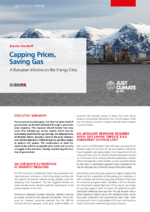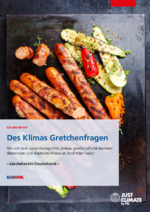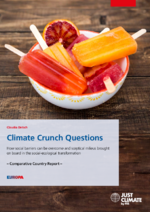Capping Prices, Saving Gas: A European Initiative on the Energy Crisis

Neuhoff, Karsten
Capping prices, saving gas
Brussels, 2022
Download publication (630 KB, PDF-File)
The current price and supply crisis that has taken hold of gas markets can be best addressed through a joint European response. This response should include two measures: First, binding gas saving targets, which also ensure strong incentives for gas savings, are adhered to by all Member States. Second, a limit on the price Transmission System Operators (TSOs) charge for gas they supply to balance the system. The combination of both elements helps achieve acceptable price levels and security of supply in the mid-term, thereby maintaining the function of gas markets.
An Adequate EU Response Is Urgently Required
The EU Commission and Member States have proposed a variety of measures to intervene in electricity and gas markets, and thus opened the door for national energy subsidies under the temporary crisis framework. This has triggered tensions between Member States and distracted from searching for an adequate response to the crisis.
Without an adequate European response, national measures are largely restricted to the provision of subsidies. These measures are, however, extremely expensive (see the 200 billion-Euro German proposal), entail great implementation uncertainties (for example relating to delays from state aid approval or unintended interactions from intra-European trade) and risk leaving consumers in poorer Member States exposed to price increases.
An Adequate Response Requires Both: Gas Saving Targets & EU Agreement on Price Limit
Gas saved in one EU Member State will reduce gas prices for all Member States and minimise the risk of curtailment. While the Council agreed to gas saving targets, most measures are still voluntary and leave room for several national exemptions (European Commission 2022). Without effective coordination, isolated efforts will engender smaller benefits as these would be diluted by free-riders. A coordinated approach makes it possible to harness the full spectrum of benefits across all Member States.
Uncertainties surrounding gas supply interruptions triggered by Russia and the impossibility of forecasting price responses, result in excessive risk premia on gas prices and lead to high costs for consumers and governments. Therefore, a limit on the price that Transmission System Operators (TSOs) pay for and charge for gas they supply in order to balance the system if a market participant withdraws more gas from the gas network than it enters (posing an implicit cap on the wholesale prices, see below) saves consumers and governments extra costs. Implementing such a limit is only possible at EU level, and should go hand in hand with coordinated gas saving measures.
Element 1: Achieving Tangible Gas Saving Targets
How Does it Work?
Member States commit to a national gas saving target. On this basis, Member States implement the necessary measures and programmes to complement gas price incentives for gas savings. They monitor national gas consumption at least on a monthly basis, and report on their achievement of the gas saving target.
If gas saving targets are combined with a European wholesale gas price limit, then Member States are required to reinstate a mechanism to ensure short-term gas saving incentives at national level.[1] They have the option to implement a quantity or price-based mechanism.
A quantity-based mechanism comprising, for example, gas saving certificates would strengthen incentives. To facilitate rapid implementation and make the incentives directly relevant, it could be implemented in an initial phase as follows:
- After each billing period, gas suppliers would need to acquire gas saving certificates to match their customers’ gas consumption.
- Gas suppliers would obtain gas certificates for free based on 70 per cent (for industry) and 80 per cent (for others) of a customer’s gas consumption in 2021
- The government would auction additional gas certificates at a fixed price and also re-purchase surplus certificates. The price would reflect the gap between price limit and market clearing prices in recent months.[2]
Alternatively, a price-based mechanism could be applied. A gas saving charge would be levied on gas consumption that exceeds 70 per cent (for industry) and 80 per cent (for others) of gas consumption in 2021.
Compliance Mechanism
Member States will have to reduce their demand for gas to the level in 2021 minus the gas saving target. In the event of a gas shortage, and if their demand is greater than that, their TSO will have to implement additional measures like supplementary auctions for gas savings or curtailment to reduce demand. This ensures that gas will be available for all Member States at the 2021 level minus the gas saving target. The mechanism implies that Member States failing to achieve the gas saving target dramatically increases the risk of curtailing domestic consumers. This will be a strong driver for compliance.
Prior to a potential shortage, EU review mechanisms (like an accelerated European semester) should be used to verify and support achievement of the national gas saving target. If gas saving targets are not met, Member States will assess the main obstacles that led to the failure and outline an action plan to get on track. The measures that Member States need to implement include
- provision of information on gas consumption and saving at a sub-national level and campaigns to engage consumers in gas saving,
- advice and support programmes to empower consumers to realise gas savings and inform about individual gas saving progress,
- regulation adjustments, for example to allow for (or even mandate) adjustments of room and water temperature, and
- financial support for implementing efficiency measures, shifting fuel away from gas, or auctions for reducing gas demand that exceeds the reduction incentivised by marginal prices.
Benefit of Gas Saving Programme
First, effective implementation of gas saving programmes will be supported by a coordinated effort at government level, and a credible commitment including compliance mechanism. Second, all EU Member States will benefit from joint commitment to gas savings through a reduction of demand for gas in the EU, lower prices and enhanced security of supply. Third, gas saving targets provide a basis for intra-European allocation of gas in case of a gas shortage. This facilitates an effective EU solidarity mechanism.
Element 2: Limiting the Gas Price in an Emergency Situation Using the TSO Imbalance Mechanism
How Does it Work?
In the European gas market, all gas suppliers (shippers) or final consumers purchasing gas have to nominate their delivery that must pass through the transmission network to the transmission system operator (TSO). If shippers nominate or deliver insufficient gas to the transmission network so as to meet demand, the national TSO purchases gas to rectify the imbalance and charges shippers the resulting imbalance cost. TSOs are obliged to acquire imbalance gas at any price, which means imbalance costs are unlimited. To avoid these costs and risks, shippers are prepared to pay a high price to acquire gas and hedge their customers against the imbalance costs.
As part of the Security of Supply regulation, the TSO should be mandated to not pay more than a price limit minus delta to purchase gas to rectify imbalance, and not to charge consumers more than the price limit for the imbalance gas. By limiting the imbalance cost, shippers will not pay more than the price limit to acquire gas to serve their consumers; as it is otherwise cheaper to nominate an imbalanced gas delivery and pay the fine (EPICO 2022 or Potoschnig, Alberto & Conti, Ilaria 2022: 22 ff.). Imposing a price limit at the level of the TSOs has the major advantages that it is relatively easy to implement and monitor. Currently there are 43 gas TSOs.
If European gas suppliers will not pay more than a price limit for gas, then prices for new contracts on pipeline delivery and in global LNG spot markets will also fall to this price limit. Producers delivering through pipeline have negligible external options, and will thus deliver gas at this price. Global LNG spot markets are dominated by EU demand[3], and if Europe’s willingness to pay drops to a price limit that is still higher than the fuel shift levels, the LNG price will drop to this level as well. Gas trading will persist, because gas producers prefer to contract suppliers willing to pay up to the price limit as opposed to TSOs which, by regulatory requirement, may not pay more than the price limit minus a delta.
Should there be insufficient supply at this price level to serve the complete demand, TSOs may attempt to balance the system using mechanisms like a reverse auction for gas saving (among industry). If this fails, the established SoS protocols for curtailment will be applied. To avoid this scenario, gas saving targets ensure sufficient additional measures are implemented by Member States to reach these targets.
The refinement of the TSO imbalance mechanism to reflect the value of lost load does not intervene in the price formation at the wholesale market level (ACER: 2022)[4], and will therefore not be considered as an intervention in existing long-term import contracts. Supply and litigation risks relating to existing long-term contracts are avoided as the TTF index and market clearing remain unchanged.
Benefits of a Gas Price Limit
First, implementing the price limit serves as a commitment device for governments to implement the complementing measures (including marginal incentives for gas savings) to avoid curtailment. Thus, EU demand will be met at or below the price limit, avoiding excessive costs for meeting demand at excessive prices as a result of inelastic demand meeting inelastic supply.
Second, a price limit reduces the average costs for gas towards the price limit. If the price limit is set sufficiently low, e.g., in the range of 50 to 70 euros/MWh, then national subsidy programmes for gas costs, as currently discussed in Germany, can be avoided.
Third, the risk for suppliers from failing to secure sufficient gas is limited. This limits the risk premia they are willing to pay in forward markets, and thus also has an effect on forward markets. With the price limit, counter-party risks are also significantly reduced as well as the need for governments to underwrite guarantees to protect margin calls and traders against downside risks.
Fourth, the agreed price limit can also serve as a basis for the remuneration of gas shared between EU Member States in the case of gas curtailment. Together with the gas saving targets, it provides a strong basis for a functioning solidarity mechanism.
The compliance mechanism would be rather straightforward: TSOs are regulated entities, usually one per EU Member State, and hence their compliance can be easily monitored. Circumvention by others is difficult to imagine, since all transactions have to pass through the gas transmission system.
Concerns that Used to Prevent an Adequate Response Can Now Be Addressed
Concern 1: Gas Price limit Undermines Gas Saving Incentives.
Solution: In Germany, which has previously been the strongest opponent to EU price limits, the commission on heat and gas concluded: a price limit can compensate for the increased costs of a basic contingency of gas (for instance, 70 to 80 per cent of a customer’s gas consumption in 2021), while retaining full incentives for short-term gas savings by retaining higher incentives on the margin. A European gas price limit can be combined with an analogous mechanism that ensures the same saving incentives for final gas consumers using pricing structures to be implemented by gas suppliers within the respective Member States.
Concern 2: National Gas Saving Targets Do Not Help Others Due to Transmission Constraints.
Solution: Rather than requiring all Member States to invariably deliver against their gas saving targets, Member States, such as Spain, would only be required to fulfil stringent saving targets if there is sufficient gas transmission or LNG shipping capacity for reduced gas demand in Spain, which would then entail additional gas availability for the rest of the EU. The European Agency for Cooperation of Energy Regulators (ACER) could be mandated to assess this situation on a continual basis.
Concern 3: Gas Price Limit Undermines Ability to Attract LNG:
The International Energy Agency's new World Gas Market Report presents an ex-post analysis of the impact of high gas prices on LNG supplies to Europe (IEA 2022). Most of the additional LNG was made available as a result of Covid lock-downs and lower than expected growth having reduced Chinese LNG imports. What is more, the high LNG prices triggered a shift away from gas to the use of coal and oil in power and industry throughout many Asian countries. According to the analysis, an LNG price around 50 euros/MWh would have been sufficient for such a fuel shift in countries where carbon pricing is not relevant for fuel choice. The IEA report subsequently assesses what additional reductions in LNG demand the LNG price exceeding the fuel shift level could have triggered in Asian economies. The IEA report determines that such additional supply is due to so-called demand destruction primarily in Pakistan, Bangladesh and Thailand. Based on this analysis, additional LNG imports to the EU based on prices exceeding the fuel shifting level of 50 euros/MWh, correspond to around one per cent of European demand. In other words: Prices beyond the fuel switch level of around 50 euros/MWh scarcely account for the re-direction of LNG to Europe, and are therefore not necessary for securing European supply.

Conclusion
The current drop in wholesale gas prices may well be a temporary phenomenon, and a renewed drastic increase in gas prices is likely over the winter and beyond when gas storage facilities need to be refilled. Member States will need to be prepared for this scenario, and agree on two elements.
First, binding gas saving targets for all Member States of the European Union to reduce gas scarcity, the price levels and risk of a gas shortage. They should comprise a commitment towards mechanisms ensuring strong incentives for gas savings and programmes to inform, engage and support consumers to realise these savings.
Second, a clearly defined limit for gas prices in emergency situations using the TSO imbalance mechanism. This avoids the risk of extremely high gas prices driving up forward prices, risk premia and requirements for ever-larger public guarantees to secure liquidity. Coming to an agreement on such a package should remain a top priority in the foreseeable future, in order to guarantee the functioning of gas and electricity markets.
Footnotes
[1] If in the absence of a European regulatory approach, member states would provide subsidies to limit gas costs, then enterprises receiving more than 50 Mio. euro support (corresponding roughly to gas consumption exceeding 1 GWh) would be required to provide a plan that specifies they will reduce the carbon footprint of their energy consumption (Art. 66 of Temporary Crisis Framework (2022). It should be considered to also include such a provision in an agreement involving a regulatory limit on gas prices.
[2] ExpertInnenkommission Gas und Wärme (2022) Sicher durch den Winter, Abschlussbericht 31.10.2022.
[3] This is due to the combination of (1) very high European LNG demand by far exceeding longer-term contracted volumes and (2) high long-term contracted LNG volumes in Asian countries but (3) lower than expected Chinese LNG demand due economic developments and Covid lock-down and (4) lower LNG imports in other Asian countries due to fuel switching from gas to oil and coal triggered by high LNG prices.
[4] Average cost of disruption of gas supply were estimated at 70 euros/MWh, with large variations across Member States and sectors.
Bibliography
ACER 2018: Study on the estimation of the cost of disruption of gas supply in Europe, https://acer.europa.eu/en/Gas/Infrastructure_development/Documents/ACER_CoDG_Final_Report_20181119_clean.pdf.
European Commission 2022: Proposal for a Council Regulation on coordinated demand reduction measures for gas, https://eur-lex.europa.eu/legal-content/EN/TXT/?uri=CELEX%3A52022PC0361&qid=1658479808193.
European Commission 2022: Temporary Crisis Framework for State Aid measures to support the economy following the aggression against Ukraine by Russia, Brussels, 28.10.2022 C(2022) 7945 final, https://competition-policy.ec.europa.eu/state-aid/ukraine_en
ExpertInnenkommission Gas und Wärme (2022) Sicher durch den Winter, Abschlussbericht 31.10.2022.
EPICO 2022: What to cap? Emergency Interventions in the European Electricity and Gas Market, https://epico.org/uploads/images/What-to-cap_-Policy-Report-_-EPICO.pdf.
IEA 2022: Gas Market Report, Q4-2022, https://www.iea.org/reports/gas-market-report-q4-2022.
Pototschnig, Alberto; Conti Ilaria 2022: Capping the European price of gas, EUI Policy Brief, https://cadmus.eui.eu/bitstream/handle/1814/74868/QM-AX-22-049-EN-N.pdf?sequence=1&isAllowed=y.
Karsten Neuhoff leads the Climate Policy Department at the German Institute for Economic Research (DIW Berlin) and is Professor at the Institute for Economics and Law of Technical University Berlin. He holds a PhD in Economics from Cambridge University and Master in Physics from Heidelberg University. His research focus on the economics and financing of a low-carbon transformation in the power, industry and building sector.
Contact
Friedrich-Ebert-Stiftung
Climate and Social Justice
Cours Saint Michel 30e
1040 Brussels, Belgium







